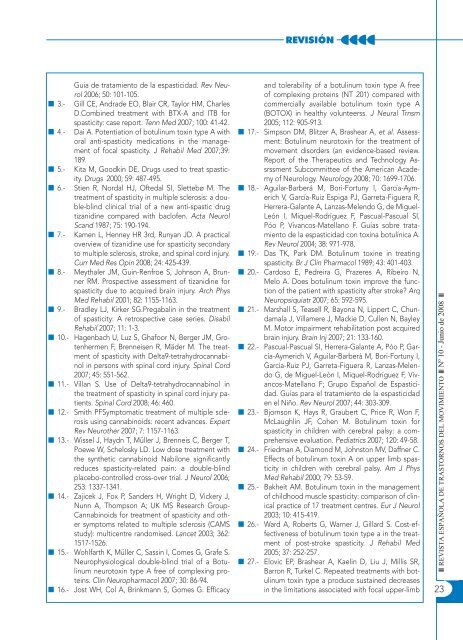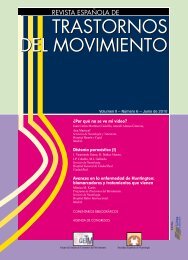REVISTA ESPAÑOLA DE - Getm.info
REVISTA ESPAÑOLA DE - Getm.info
REVISTA ESPAÑOLA DE - Getm.info
You also want an ePaper? Increase the reach of your titles
YUMPU automatically turns print PDFs into web optimized ePapers that Google loves.
■<br />
■<br />
■<br />
■<br />
■<br />
■<br />
■<br />
■<br />
■<br />
■<br />
■<br />
■<br />
■<br />
■<br />
Guia de tratamiento de la espasticidad. Rev Neurol<br />
2006; 0: 101-10 .<br />
.- Gill CE, Andrade EO, Blair CR, Taylor HM, Charles<br />
D.Combined treatment with BTX-A and ITB for<br />
spasticity: case report. Tenn Med 2007; 100: 41-42.<br />
.- Dai A. Potentiation of botulinum toxin type A with<br />
oral anti-spasticity medications in the management<br />
of focal spasticity. J Rehabil Med 2007;39:<br />
189.<br />
.- Kita M, Goodkin <strong>DE</strong>. Drugs used to treat spasticity.<br />
Drugs 2000; 59: 487-495.<br />
6.- Stien R, Nordal HJ, Oftedal SI, Slettebø M. The<br />
treatment of spasticity in multiple sclerosis: a double-blind<br />
clinical trial of a new anti-spastic drug<br />
tizanidine compared with baclofen. Acta Neurol<br />
Scand 1987; 75: 190-194.<br />
7.- Kamen L, Henney HR 3rd, Runyan JD. A practical<br />
overview of tizanidine use for spasticity secondary<br />
to multiple sclerosis, stroke, and spinal cord injury.<br />
Curr Med Res Opin 2008; 2 : 2 - 9.<br />
8.- Meythaler JM, Guin-Renfroe S, Johnson A, Brunner<br />
RM. Prospective assessment of tizanidine for<br />
spasticity due to acquired brain injury. Arch Phys<br />
Med Rehabil 2001; 82: 11 -116 .<br />
9.- Bradley LJ, Kirker SG.Pregabalin in the treatment<br />
of spasticity: A retrospective case series. Disabil<br />
Rehabil 2007; 11: 1-3.<br />
10.- Hagenbach U, Luz S, Ghafoor N, Berger JM, Grotenhermen<br />
F, Brenneisen R, Mäder M. The treatment<br />
of spasticity with Delta9-tetrahydrocannabinol<br />
in persons with spinal cord injury. Spinal Cord<br />
2007; 45: 551-562.<br />
11.- Villan S. Use of Delta9-tetrahydrocannabinol in<br />
the treatment of spasticity in spinal cord injury patients.<br />
Spinal Cord 2008; 6: 60.<br />
12.- Smith PFSymptomatic treatment of multiple sclerosis<br />
using cannabinoids: recent advances. Expert<br />
Rev Neurother 2007; 7: 1157-1163.<br />
1 .- Wissel J, Haydn T, Müller J, Brenneis C, Berger T,<br />
Poewe W, Schelosky LD. Low dose treatment with<br />
the synthetic cannabinoid Nabilone significantly<br />
reduces spasticity-related pain: a double-blind<br />
placebo-controlled cross-over trial. J Neurol 2006;<br />
253: 1337-1341.<br />
1 .- Zajicek J, Fox P, Sanders H, Wright D, Vickery J,<br />
Nunn A, Thompson A; UK MS Research Group-<br />
Cannabinoids for treatment of spasticity and other<br />
symptoms related to multiple sclerosis (CAMS<br />
study): multicentre randomised. Lancet 200 ; 62:<br />
1517-1526.<br />
1 .- Wohlfarth K, Müller C, Sassin I, Comes G, Grafe S.<br />
Neurophysiological double-blind trial of a Botulinum<br />
neurotoxin type A free of complexing proteins.<br />
Clin Neuropharmacol 2007; 30: 86-94.<br />
16.- Jost WH, Col A, Brinkmann S, Gomes G. Efficacy<br />
■<br />
■<br />
■<br />
■<br />
■<br />
■<br />
■<br />
■<br />
■<br />
■<br />
■<br />
REVISIÓN<br />
and tolerability of a botulinum toxin type A free<br />
of complexing proteins (NT 201) compared with<br />
commercially available botulinum toxin type A<br />
(BOTOX) in healthy volunteerss. J Neural Trnsm<br />
200 ; 112: 90 -91 .<br />
17.- Simpson DM, Blitzer A, Brashear A, et al. Assessment:<br />
Botulinum neurotoxin for the treatment of<br />
movement disorders (an evidence-based review.<br />
Report of the Therapeutics and Technology Assrssment<br />
Subcommittee of the American Academy<br />
of Neurology. Neurology 2008; 70: 1699-1706.<br />
18.- Aguilar-Barberá M, Bori-Fortuny I, García-Aymerich<br />
V, García-Ruiz Espiga PJ, Garreta-Figuera R,<br />
Herrera-Galante A, Lanzas-Melendo G, de Miguel-<br />
León I, Miquel-Rodríguez F, Pascual-Pascual SI,<br />
Póo P, Vivancos-Matellano F. Guías sobre tratamiento<br />
de la espasticidad con toxina botulínica A.<br />
Rev Neurol 2004; 38: 971-978.<br />
19.- Das TK, Park DM. Botulinum toxine in treating<br />
spasticity. Br J Clin Pharmacol 1989; : 01- 0 .<br />
20.- Cardoso E, Pedreira G, Prazeres A, Ribeiro N,<br />
Melo A. Does botulinum toxin improve the function<br />
of the patient with spasticity after stroke? Arq<br />
Neuropsiquiatr 2007; 65: 592-595.<br />
21.- Marshall S, Teasell R, Bayona N, Lippert C, Chundamala<br />
J, Villamere J, Mackie D, Cullen N, Bayley<br />
M. Motor impairment rehabilitation post acquired<br />
brain injury. Brain Inj 2007; 21: 133-160.<br />
22.- Pascual-Pascual SI, Herrera-Galante A, Póo P, García-Aymerich<br />
V, Aguilar-Barberà M, Bori-Fortuny I,<br />
García-Ruiz PJ, Garreta-Figuera R, Lanzas-Melendo<br />
G, de Miguel-León I, Miquel-Rodríguez F, Vivancos-Matellano<br />
F; Grupo Español de Espasticidad.<br />
Guías para el tratamiento de la espasticidad<br />
en el Niño. Rev Neurol 2007; 44: 303-309.<br />
2 .- Bjornson K, Hays R, Graubert C, Price R, Won F,<br />
McLaughlin JF, Cohen M. Botulinum toxin for<br />
spasticity in children with cerebral palsy: a comprehensive<br />
evaluation. Pediatrics 2007; 120: 49-58.<br />
2 .- Friedman A, Diamond M, Johnston MV, Daffner C.<br />
Effects of botulinum toxin A on upper limb spasticity<br />
in children with cerebral palsy. Am J Phys<br />
Med Rehabil 2000; 79: 53-59.<br />
2 .- Bakheit AM. Botulinum toxin in the management<br />
of childhood muscle spasticity: comparison of clinical<br />
practice of 17 treatment centres. Eur J Neurol<br />
200 ; 10: 1 - 19.<br />
26.- Ward A, Roberts G, Warner J, Gillard S. Cost-effectiveness<br />
of botulinum toxin type a in the treatment<br />
of post-stroke spasticity. J Rehabil Med<br />
2005; 37: 252-257.<br />
27.- Elovic EP, Brashear A, Kaelin D, Liu J, Millis SR,<br />
Barron R, Turkel C. Repeated treatments with botulinum<br />
toxin type a produce sustained decreases<br />
in the limitations associated with focal upper-limb<br />
<strong>REVISTA</strong> <strong>ESPAÑOLA</strong> <strong>DE</strong> TRASTORNOS <strong>DE</strong>L MOVIMIENTO Nº 10 - Junio de 2008<br />
2



